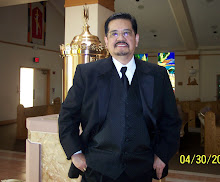 The month of May is a very special month in our family. It is the birthday month of five of my siblings.
The month of May is a very special month in our family. It is the birthday month of five of my siblings.May 9, 11, 12, 14 and 23. One niece also celebrates hers on the 12th. The Fiesta of our town in Nueva Ecija also falls on May 12th, so does the Fiesta in Santa Ana, Manila (Feast of St. Anne), where I spent my childhood years.
May is the merriest month in the Philippines. That's because it is summertime; so most town fiestas occur on this month. The annual Santa Cruzan is also held on this month, which is a Catholic tradition of commemorating the journey to find the crucifix of Jesus by King Constantine and her mother, Queen Helena.
According to historical accounts, Constantine, the emperor of Rome some thousand years ago, dreamt that he should go to the battle field to fight in the name of the Holy Cross. He conquered his enemy and that victory led to his conversion to Christianity. He became the first Christian emperor in history. His mother, Queen Helena, was inspired by all these experiences and in the year 326 A.D., she went on a pilgrimage to the Holy Land to seek the Holy Cross, the wooden cross on which Christ was supposed to have been nailed. She successfully found the Holy Cross, complete with its inscription `INRI` on its top.
Thus, the religious Santa Cruzan procession is a re-enactment of the finding of the Holy Cross by Reyna Elena.
Of course, May is the month of the Blessed Virgin Mary. So, in Catholic churches worldwide, there would be a twelve-day novena and floral offerings to Mother Mary, and which would culminate in the Flores de Mayo in the Philippines, the official May procession held by Philippine catholic parishes.
Corollary to this Catholic tradition is the neighbourhood procession called Lutrina. Originally, the Lutrina was meant to be festivities and rituals related to the the planting season which occurs in May.
The alay originally came from the very ancient past when young girls, always the symbol of purity and renewal, went to the sacred caves to offer garlands of flowers to the anito or the spirits of the forefathers. Then, it was reconfigured into the Christian tradition, and alay became the offering of the young for the Holy Virgin, then the offerings were replaced by flowers.
The lutrina, or the prayers were originally uttered by farmers as they walked through barren fields, were pleadings for the first rain. These days, the 12-day lutrina would culminate into the Santa Cruzan, where neighbourhood beauties - young girls and dalagitas - become sagalas. The last of the sagalas is always the Emperatris or Reyna Elena with her little constantino.
Nowadays, in many small nooks of Santa Ana and Mandaluyong, countless lutrinas are being held in May. But when I was growing up in one particular Santa Ana neighbourhood, there was only one lutrina, and it was started by my Lola. It was always started on May 14th, the birthday of one of my sisters. So, all my sisters and cousins, at one time or another, became "sagalas" in this Santa Cruzan and also in theFlores de Mayo.
This is also the reason, why we townsfolk of Punta and Mandaluyong, could eloquently sing the "Dios te Salve Maria."
Here in Toronto, the Filipino Catholic Mission (previously called the Filipino Chaplaincy) celebrates its own Santa Cruzan. At the old chaplaincy, we used to participate in the procession, where young Filipino- Canadian girls and boys donned their gowns and barongs, and the procession would take on the route around the high-rise apartment buildings and a park to the accompaniment of a Banda Filipino or musiko.









